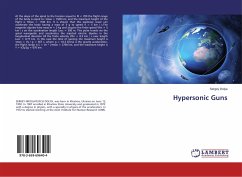At the slope of the spiral to the horizon equal to = 700 the flight range of the body is equal to: Smax = 1600 km, and the maximum height of the flight is Hmax = 1100 km. It is shown that this explosive wave can accelerate the body having a mass of 3 g to speed V = 5 km / s.The magnetic dipoles have mass m = 2 kg and acquire the finite speed Vfin = 5 km / s on the acceleration length Lacc = 300 m. This pulse travels via the spiral waveguide and accelerates the injected electric dipoles in the longitudinal direction till the finite velocity Vfin = 8.5 km / s over length Lacc = 0.77 km. In this case the time of gaining the maximum height is max = Vy / g = 367 s, where g = 10-2 km/s2 is the gravity acceleration, the flight range is S = Vx 2 max = 2700 km, and the maximum height is Y = V2y/2g = 670 km.
Bitte wählen Sie Ihr Anliegen aus.
Rechnungen
Retourenschein anfordern
Bestellstatus
Storno








